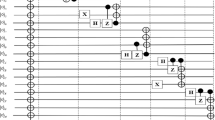Abstract
This paper presents an extension of the original strange planet protocol with three species who mate in a special way, to \(m\) species and reveals essential principles in the new protocol. Further, must-fail, might-fail and cannot-fail states are formalized and the relationship among them is established. Moreover, the number of each kind of states is calculated. In addition, the conditions for secure communications based on the new protocol are given. Finally, an application is provided to illustrate how the extended strange planet protocol can be used for secure communication.



Similar content being viewed by others
References
Adamatzky A, Alonso-Sanz R, Lawniczak A (2008) Automata-2008: theory and applications of cellular automata. Luniver Press, Beckington
Agrawal D, Zeng QA (2010) Introduction to wireless and mobile systems. Cengage Learning, Radford
Burks AW (1970) Essays on cellular automata. University of Illinois Press, Champaign
Cameron PJ (1994) Combinatorics: topics, techniques, algorithms. Cambridge University Press, Cambridge
Codd EF (1968) Cellular automata. Academic Press Inc, New York
Comer D (1995) Internetworking with TCP/IP, vol. I: pinciples, protocols, and architecture, 3/e. Prentice-Hall, Englewood Cliffs
Gajardo A, Goles E, Moreira A (2001) STACS 2001., Generalized langtons ant: dynamical behavior and complexitySpringer, Berlin, pp 259–270
Gajardo A, Moreira A, Goles E (2002) Complexity of langton’s ant. Discret Appl Math 117:41–50
Gardner M (1970) Mathematical games: the fantastic combinations of john conways new solitaire game life. Sci Am 223:120–123
Holzmann GJ (1991) Design and validation of computer protocols. Pretentice Hall, Upper Saddle River
Hopcroft JE, Motwani R, Ullman JD (2000) Introduction to automata theory, languages, and computation. Pearson Education, New York
Perlman R (2000) Interconnections: bridges, routers, switches, and internetworking protocols. Addison-Wesley Professional, Boston
Rich E (2008) Automata, computability and complexity: theory and applications. Pearson Prentice Hall, Upper Saddle River
Silverman JH (2006) A friendly introduction to number theory. Am Math Compet 10:12
Stallings W (1995) Network and internetwork security: principles and practice. Prentice-Hall Inc, Englewood Cliffs
Stallings W, Stallings W (1997) Data and computer communications, vol 6. Prentice hall New Jersey, Upper Saddle River
Stark HM (1970) An introduction to number theory. Markham Publishing Company Chicago, Illinois
Tao R (2008) Finite automata and application to cryptography. Springer, Chicago
Tian C, Duan Z, Liu J (2014) Secure communications with strange planet protocol. Optim Lett 8(1):201–209
Acknowledgments
This research is supported by the NSFC Grant Nos. 61133001, 61272118, 61272117, 61202038, 91218301,61322202, 61373043 and National Program on Key Basic Research Project (973 Program) Grant No. 2010CB328102
Author information
Authors and Affiliations
Corresponding author
Appendix
Appendix
The pseudo code written in C++ computing \(P(n,m)\), the number of circle states is as follows:


The pseudo code for computing \(k\)-partition of positive integer \(n\) under the condition that each partition is not more than \(max\)

Rights and permissions
About this article
Cite this article
Liu, J., Duan, Z., Tian, C. et al. An extended strange planet protocol. J Comb Optim 30, 299–319 (2015). https://doi.org/10.1007/s10878-014-9750-0
Published:
Issue Date:
DOI: https://doi.org/10.1007/s10878-014-9750-0



